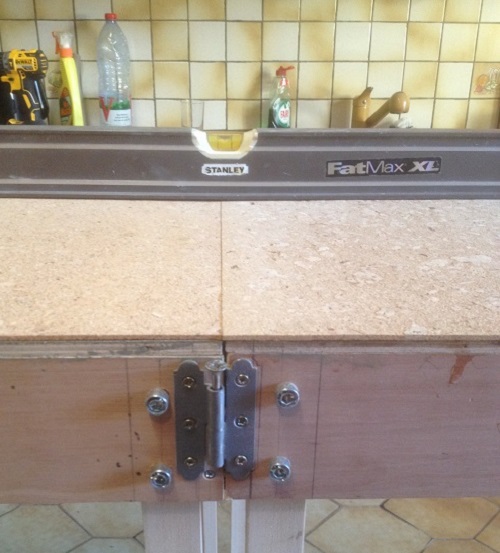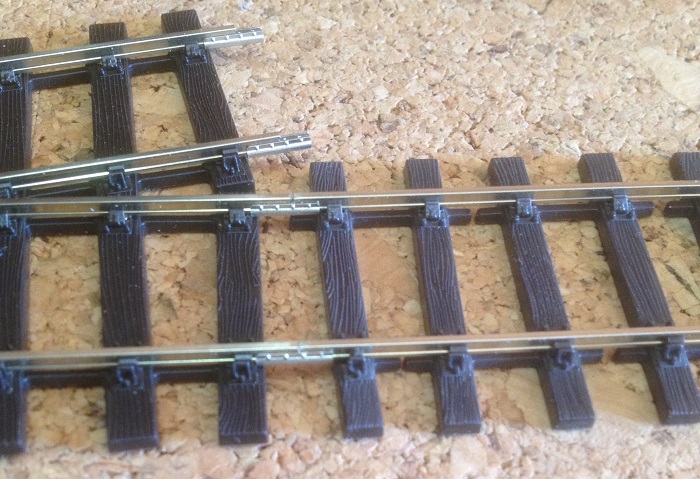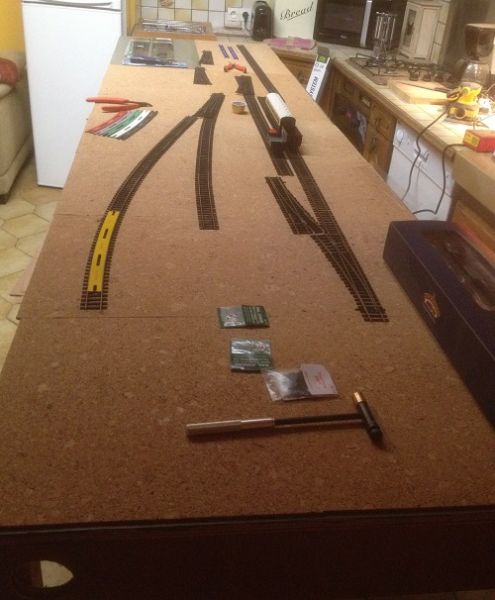Newton Regis, it'll never be finished, hopefully!
Posted
Full Member
A GWR journey through the 1920s and 30s
Its fascinating watching you follow in my footsteps Bill. Its almost 13 years to the day when I set up my branch so I could learn the mysteries of DCC…..and shortly after RR&Co.You have made a far better start than I…….your baseboards look superb. I am sure they will make a perfect level stable foundation for the track.
You have also, almost certainly, planned the layout more carefully than I. Having said that….I would be in no rush to ballast. My big regret was rushing into the scenery before I had really evaluated the operation of the layout.. It is much easier shifting a turnout or extending a siding that is not ballasted. One of the flaws in my plan was not to allow enough space for the dead space/ fouling area where a turnout connects thus limiting the capacity of the loop or siding. Knowing your attention to detail you have probably allowed for this but nothing beats seeing it actually in practise.
I doubt if you will have any major issues with the electrics. DCC is pretty straight forward provided you have installed a reliable circuit breaker like the PSX
Delighted to see Newton Regis progressing at such a fine confident pace.
Posted
Full Member
You've made an excellent start but John is absolutely right about not rushing things. My advice would also be to make sure your trackwork is perfect before you think of moving on. There's nothing more frustrating than trying to redo or match existing scenery in a place where you've had to tweak either the track or, more often, a point where just some of your locos regularly derail !!
I'm hoping December 31st won't bring any surprises although a "no-deal" scenario keeps rearing it's ugly head and that could upset the apple cart.
'Petermac
Posted
Full Member
It’s good to know I’m following a well trodden path, so I’ll be looking for tell-tale signs along the way to keep heading forward. As with almost all things, aspects of this hobby become easier with repetition, so I reckon the next baseboards I build will be more accurate and built quicker, as I’ll have already trodden that path . . .
I’m aware with the ease of overlooking those dead areas with turnouts when first drawing track plans and am grateful to have not rushed in to lay track and find the plan inadequate for purpose. Fortunately or not, I’ve been a planner most of my life and it’s been pretty useful so far.
I couldn’t agree with you more about that very dark art Peter and having spent an hour or more last night, pouring over DCC wiring technical advice sheets on DCC Concepts’ website, I’m now even more convinced of the need for terrestrial super powers to understand even half as much as electrical design engineers seem to. However, I do understand enough to know that I need to draw up a wiring diagram for the track plan and not try and wing it once the track is down.
The branch will be wired as a single power district with circuit breaker protection for the track bus. The accessory bus for turnouts and signalling could go through the command station, as the PSX 1 allows for, but would it be better to have a second PSX for this? My 2Amp NCE Power Cab would be fed by a regulated 18v power supply.
If and when I graduate from the branch to the larger layout, I’ll upgrade the NCE to the 5Amp system and introduce more power districts to better handle short detection and fault finding.
How am I doing so far?
Thing is, I know we all have super powers, but not how to activate them!
Bill
 Last edit: by Longchap
Last edit: by Longchap
At 6'4'', Bill is a tall chap, then again, when horizontal he is rather long and people often used to trip over him! . . . and so a nickname was born :)
Posted
Full Member
………………………………………………………………………………………………..I do understand enough to know that I need to draw up a wiring diagram for the track plan and not try and wing it once the track is down.
…………………………………………………………………………………
Oh bother and blast - I knew I'd forget something ………………………………… :oops: :oops: :oops: :oops: :oops:
'Petermac
Posted
Full Member
Electrics are a complete mystery to me too. So far I have survived by following instructions carefully without really understanding the reasons….. but it works!
Michael
Posted
Full Member
Sounds good……as I rather expected you seem to have all the bases covered hence my rather carefully worded post.:lol:.
My accessory bus is powered by a dedicated 16v AC transforner…..I didnt know that it could be protected by a PSX…..I have never had any significant issues with the accessory bus so I am not sure if you need that level of protection
Am I right in thinking you are goung to mimic panels to throw the turnouts not accessory decoders?
Not sure if you have determined where to mount your PSXs but I could I recommend fitting them where they are always in view when operating. They are absolutely invaluable…..first thing I check if a loco stalls is to check the PSX red lights are correct….saves a load of time.
Wiring: there is a thread on RM web “Mid Cornwall Lines 1950†posted by an ex B.R. Engineer now working with the railway in in Australia. He is very talented …just finished a number of working ground signals! As you can imagine his wiring is a joy (or embarrassment in my case!) to behold. In addition to the usual colour coding not only are all the terminal blocks neatly labelled with a dymo type printer but the wires themselves are similarly tagged…..he just takes a bit of the backing off at one end of the label and wraps it around the wire….very near.
Best wishes
 Last edit: by John Dew
Last edit: by John Dew
Posted
Full Member
Michael, I’ve just covered half the paint job with cork tile, but will cut it back once the track has been precisely located and marked out, ie, after running various types of stock over all the track to ensure all desired movements are actually possible.
John, you will not be too surprised to hear that I’ve spent some considerable time today in mid-Cornwall. What an amazing layout in so many ways and always good to see a master at work. I’m using his borrowed design for the lift up section. Quite brilliant.
I’ve also tracked down a PSX in stock today, so will get it on order before it gets nabbed!
Time for a beverage now methinks, something with ice, lemon and tonic innit!
Cheers,
Bill
 Last edit: by Longchap
Last edit: by Longchap
At 6'4'', Bill is a tall chap, then again, when horizontal he is rather long and people often used to trip over him! . . . and so a nickname was born :)
Posted
Full Member
After sealing the plywood tops with paint, I decided to lay cork tile over all track areas and cut back as necessary only once the track is laid and tested.

Happiness is a level baseboard, thanks to adjustable feet!
This is the first time I’ve used code 75 track. The bullhead has an even sleeker profile than flat bottomed and the first thing I noticed was how easy the flex-track is to bend compared to code 100. It’s so bendy, it seems to go out of shape as soon as you turn your back on it. The Tracksetta profiles came in very handy though and as soon as it was straight, I pinned it down.
Starting with the run round loop, I slowly set out, aligned, trimmed and pinned the track and drilled holes through the boards for frog power and point motor actuation rods, as the points were positioned. Fitting the rail joiners proved to be a frustratingly long job and not yet finished, simply due to the miniscule size of the little blighters, but they do look good with a representations of fish-plates and bolts, not dissimilar to C&L Finescale flexi-track.


This was the tidy baseboard before drilling, cutting, trimming of sleepers and dropping rail joiners and track pins began, nor the boards covered in tools and debris. Fortunately I had plenty of small containers to hand to keep the tiny rail joiners, track pins and tie bar springs safe. Why didn’t I simply bin those springs? I probably will tomorrow.
I might get the rest of the track down tomorrow, but am not rushing it, although I am looking forward to getting a loco to trundle round soon for testing purposes.
Bonne soirée
Bill
 Last edit: by Longchap
Last edit: by Longchap
At 6'4'', Bill is a tall chap, then again, when horizontal he is rather long and people often used to trip over him! . . . and so a nickname was born :)
Posted
Full Member
Wont be long before the first train…..which one will have the honour?:lol:
Keep well
Posted
Full Member
There is no need to use unsightly IRJs with Unifrog points, provided you are operating with DCC, as the whole point is wired to be live, with the exception of the insulated frog, which has a wire attached to hook it to power and polarity switching.

Packaging image included solely for instructive purposes.
The first loco for a GWR layout really should be a pannier, although the rostered Newton Regis loco will probably be a 45xx, as was the loco at my childhood village station of Princetown.
It will also be interesting to see if a Hornby 0-4-0 Peckett stalls on the small insulated frog tip, although I’ll be feeding the frogs for all live operation, with polarity control handled by the Tortoise.
Best,
Bill
 Last edit: by Longchap
Last edit: by Longchap
At 6'4'', Bill is a tall chap, then again, when horizontal he is rather long and people often used to trip over him! . . . and so a nickname was born :)
Posted
Full Member
It’s coming on nicely.
Posted
Full Member
I've just had some time to catch up with your thread and it looks like things are beginning to progress nicely again. Your first track plan for the branch was very similar to Much Murkle but I like your new one.
I ordered some bullhead points for a new project back in early May from Rails of Sheffield and still haven't had delivery. No-one seems to have them in stock for months. Did you already have yours before Covid struck earlier in the year? If not where did you get them from?
Has your Mogul arrived yet? I'm very pleased with mine and I'm just about to undergo the trials and tribulations of fitting DG's to it.
All the best, Nick
Posted
Full Member
Of course…….do keep up at the back Dew! :oops:Hi John,
There is no need to use unsightly IRJs with Unifrog points, provided you are operating with DCC, as the whole point is wired to be live, with the exception of the insulated frog, which has a wire attached to hook it to power and polarity switching.

Packaging image included solely for instructive purposes.
The first loco for a GWR layout really should be a pannier, although the rostered Newton Regis loco will probably be a 45xx, as was the loco at my childhood village station of Princetown.
It will also be interesting to see if a Hornby 0-4-0 Peckett stalls on the small insulated frog tip, although I’ll be feeding the frogs for all live operation, with polarity control handled by the Tortoise.
Best,
Bill
An ultra reliable Pannier was always my first choice to test…..followed by a Prairie.
Posted
Full Member
Thanks Chris, I'm finding, unlike most things, fitting the little chaps is getting no easier with repetition!That bullhead track looks great. The joiners especially.
It’s coming on nicely.
I am however looking forward to painting the trackwork and weathering the ballast, if not actually doing the ballasting itself. At least there's only 6 metres of it and fortunately, I'm in no hurry.
Bill
At 6'4'', Bill is a tall chap, then again, when horizontal he is rather long and people often used to trip over him! . . . and so a nickname was born :)
Posted
Full Member
Hi Nick,Hi Bill
I've just had some time to catch up with your thread and it looks like things are beginning to progress nicely again. Your first track plan for the branch was very similar to Much Murkle but I like your new one.
I ordered some bullhead points for a new project back in early May from Rails of Sheffield and still haven't had delivery. No-one seems to have them in stock for months. Did you already have yours before Covid struck earlier in the year? If not where did you get them from?
Has your Mogul arrived yet? I'm very pleased with mine and I'm just about to undergo the trials and tribulations of fitting DG's to it.
All the best, Nick
Always good to hear from you and yes the old plan does look reminiscent of Much Murkle, a firm favourite of mine and I’m looking forward in due course to discover what your next project will be.
I did have a small amount of bullhead points in stock, as part of forward planning and then snapped up a couple of stragglers from Hattons just as stocks were running out and very glad I did with all the madness of this year. I'm just sorry that I can't help more.
I was going to use some medium radius on the main line storage loops, but Peco have consistently remained silent about release dates for these, together with large radius units, slips and crossovers. Hattons did take payment from me yesterday however, for a back order of 4 packs of bullhead rail joiners, so just perhaps, things are beginning to move!
It will be 2 weeks this comming Monday since my Mogul order was posted, so they should be here soon. Hattons are usually pretty good, although one order took 4 weeks to arrive once. Fingers crossed!
All the best with your new project and continued good health to MM.
Best,
Bill
 Last edit: by Longchap
Last edit: by Longchap
At 6'4'', Bill is a tall chap, then again, when horizontal he is rather long and people often used to trip over him! . . . and so a nickname was born :)
Posted
Full Member
I'm not sure if the Prairie is too heavy for branch use John, but it will look sweet with surburban stock behind it, so I'll only part fill the tanks and bunker!
An ultra reliable Pannier was always my first choice to test…..followed by a Prairie.
Be safe,
Bill
 Last edit: by Longchap
Last edit: by Longchap
At 6'4'', Bill is a tall chap, then again, when horizontal he is rather long and people often used to trip over him! . . . and so a nickname was born :)
Posted
Full Member
Michael
Posted
Full Member
Unifrog points are factory wired with DCC users in mind and so appear to be much easier to install than Electrofrogs, with no further user modifications to be made. They therefore seem to be fairly straightforward and I'm looking forward to getting everything installed and wired up.
I never thought I'd say this, but I'm even looking forward to getting to grips with the control panel for route setting, thanks to clever use of integrated modular electronics by Berrett Hill Shop in the US. Like you, I'll be following the instructions carefully and keeping my fingers crossed for a happy outcome.
Oh and yes, the ties are spaced more prototypically, so an end to cutting all the webs and respacing the sleepers, which took me an age to do on my practice plank!
Stay safe,
Bill
 Last edit: by Longchap
Last edit: by Longchap
At 6'4'', Bill is a tall chap, then again, when horizontal he is rather long and people often used to trip over him! . . . and so a nickname was born :)
Posted
Full Member
[user=434]John Dew[/user] wrote:I'm not sure if the Prairie is too heavy for branch use John, but it will look sweet with surburban stock behind it, so I'll only part fill the tanks and bunker!
An ultra reliable Pannier was always my first choice to test…..followed by a Prairie.
Be safe,
Bill
Actually I was thinking of a small prairie …although large prairies did have the same route availabilty (blue) as Panniers……but I am inclined to agree a large prairie would look a bit out of place on the branch.
Keep well
Posted
Full Member
Those rail joiners look great although I can miagine they're blighters to fit. Have you made one of those clever gadgets Chubber used for rail joiners ? I made one and absolutely wouldn't be without it.
The detail looks good on the track too - from your comments, do I understand you no longer need to trim the chairs off the first sleeper so the joiner can slide under it ? I simply remove the first couple of sleepers completely and glue dummies in place before ballasting - much easier than trying to undercut the chairs.
It's a fact that, whenever one sees a new layout taking shape, you feel an element of excitement build up - either that or I'm having a hot flush ……………………. :shock:
'Petermac
1 guest and 0 members have just viewed this.

